- EMERGING
STRONGER - OPERATING & FINANCIAL REVIEW
- ENVIRONMENTAL, SOCIAL AND GOVERNANCE REVIEW
- FINANCIAL STATEMENTS
- Directors’ Statement
- Independent Auditors’ Report
- Balance Sheets
- Consolidated Income Statement
- Consolidated Statement of
Comprehensive Income - Consolidated Statement of
Changes in Equity - Consolidated Statement of
Cash Flows - Notes to the Financial Statements
- Supplementary Information
- EVA Statement
- Shareholders' Information
- Governance Disclosure Guide
- Corporate Information
- Notice of Annual General Meeting
- Proxy Form
- Letter to Shareholders
- Financial Calendar
OUR MATERIAL ESG ISSUES
Environmental
To responsibly manage and reduce our impact on the environment as well as to effectively manage environmental risks to our operations

Why this is material
Climate Change
As an energy player, our power generation activities release greenhouse gas emissions that impact the climate. Events and actions by governments in response to climate change pose potential regulatory, physical and supply risks to our businesses. The Paris Agreement on climate change has been ratified by countries representing over 80% of global greenhouse gas emissions. However, as a provider of energy and water solutions, we recognise that we are also uniquely positioned to leverage opportunities that have arisen from climate change developments. From renewable energy to environmentally-friendly total water and wastewater solutions, we are actively investing in green business lines.
Local Environmental Protection
As a result of the products and services we provide, our operations have varying direct and indirect impacts on the environment. These include the release of NOX, SOX and particulate matter, as well as the discharge of effluent and the disposal of waste. Improper or non-compliant emission, discharge or disposal not only result in harm to the environment, but also threaten the long-term viability of our business, and go against our Statement of Commitment to Environmental Protection.
Energy and Water Efficiency
Achieving optimal energy and water efficiency is a business driver for us. Maximising our efficiency and optimising our operations reduces our consumption of natural resources while enhancing our returns. In the face of rising energy costs and water scarcity, energy and water efficiency are becoming increasingly critical to ensure the long-term sustainability of our business.
Our approach
Climate Change
We are committed to managing the impact of our businesses on climate and the environment in a responsible manner. At the same time, we believe that our businesses, including our power generation business, support economic development and enhance the standard of living for communities. To mitigate potential regulatory, physical and supply risks, we are aligned with and support climate change positions set out by governments in their Intended Nationally Determined Contributions in countries where we have significant energy operations. We also review the potential impact of climate change on our facilities at project due diligence stage, to inform the design and construction of our assets and ensure we have the appropriate safeguards. We keep abreast of developments pertinent to climate change through participation on platforms such as Singapore’s National Climate Change Network. We believe we are well-positioned to manage climate change risks and opportunities through:
i. Growing our renewable energy business as part of a balanced portfolio
We maintain a diversified energy generation portfolio of thermal and renewable energy assets comprising facilities fuelled by gas, coal, wind, solar, energy-from-waste and biomass. We believe that thermal energy continues to be relevant. In addition to gas, we believe that coal, an affordable and abundant fuel, will continue to play an important role in the fuel mix in rapidly developing economies. However, cleaner and higher-efficiency coal technologies will become increasingly important in meeting pressing needs for both electrification and lower emissions. On the other hand, significant focus has been placed on expanding our renewable and low-carbon energy portfolio. We strengthened our specialist renewable energy teams at our corporate office as well as in China and India in 2015 to actively pursue renewable assets via acquisitions and organic growth. In 2016, our total renewable and low-carbon portfolio grew from 1,546 megawatts to 1,807 megawatts. Currently, we have renewable wind and solar power assets in Singapore, China and India, and both biomass and energy-from-waste operations in Singapore and the UK.
ii. Building and maintaining energy-efficient power and water facilities
Sembcorp builds energy-efficient facilities. These include assets utilising supercritical coal-fired technology, combined cycle gas turbines and combined power and desalination technologies. In addition, we incorporate energy efficiency considerations across the design, operation and maintenance phases of our facilities to further reduce our indirect carbon emissions. We utilise data and predictive analytics to improve plant efficiency and performance in our operations.
Local Environmental Protection
Sembcorp’s Statement of Commitment to Environmental Protection and Environmental Protection Management Guidelines set out our principles and practices in the area of environmental protection. We aim to comply fully with all regulations and requirements, and consume resources prudently, focusing on reduction at source. We assess the impact of environmental risks and apply appropriate control measures to manage them. We apply stringent controls in the management of waste generated by our operations, strive at all times to adhere to discharge and emission limits set by local authorities and implement containment measures to minimise any direct impact to the environment and the surrounding community. As a wastewater treatment service provider, our capabilities in treating multiple streams of industrial wastewater from our customers allow us to meet effluent discharge standards. We also have a comprehensive water sampling and testing regime that helps us ensure compliance with such standards.
We aim to minimise impacts through prevention, reduction, reuse and recycling, and seek innovative ways to adopt a circular economy approach to waste. We actively develop capabilities to recover energy from waste. For example, at our Sembcorp Woodchip Boiler Plant in Singapore, woodchips processed from waste wood collected by our solid waste management operations are used to produce economical renewable steam. Also, treated effluent from our wastewater treatment facilities is further treated to produce demineralised water at our water reclamation facilities. We do not draw groundwater for power generation, but rely on seawater to meet the water needs of our power plants. In addition, our design and construction business utilises fly ash, a by-product of coal combustion in power plants, as a material for blended cement, mosaic tiles and hollow blocks.
We conduct environmental assessments in accordance with national and / or international standards and methodologies. These include environmental and social impact assessments, environmental baseline studies and pollution control studies. Recommendations from the assessments form part of our management of HSE risks and these recommendations are incorporated into the planning, designing, construction and commissioning of new plants.
Energy and Water Efficiency
Where viable, we invest in the latest technologies and utilise our capabilities as an industry leader to achieve better energy and water efficiency, including the reduction of water consumption through water reuse. Energy and water efficiency parameters are embedded in our plant operation management systems, and are monitored daily. These parameters are reported to management on a monthly basis where deviation and performance gaps are reviewed, and improvement plans are discussed for implementation. Our Group Technology department collaborates with academic and research institutions, technology suppliers and end users to develop innovative solutions and continuously improve our processes, ensuring the optimal performance of our facilities. We also utilise the Sembcorp Global Asset Management System, a data and predictive analytics tool, to help us optimise our operations and improve efficiency.
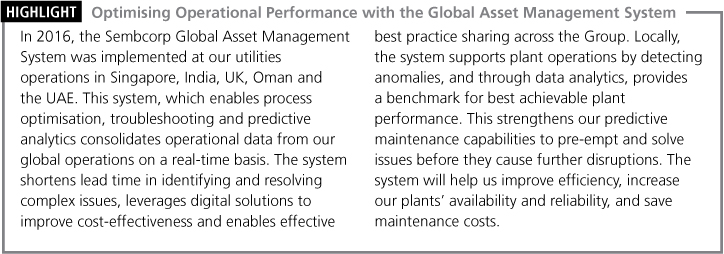
Water availability
We leverage Sembcorp’s total water management capabilities for better efficiency and resource conservation for our own operations as well as our customers. By integrating wastewater treatment, water reclamation and water supply into a “closed loop”, we aim to minimise liquid discharge, reducing environmental impact while conserving water resources.
Our energy-efficient large-scale integrated power and desalination plants use multi-stage flash distillation and reverse osmosis to provide high-quality water to industries and households in water-scarce areas such as Oman and the UAE. In some of our power plants, we employ closed-loop cooling water systems to further minimise water drawn from the ocean.
Our energy and water efficiency efforts also apply to our office and administrative buildings, and we actively seek to reduce our consumption of energy and water through responsible use and equipment upgrades.

Our performance
In 2016, we embarked on the replacement of the chillers at our corporate headquarters in Singapore. The building was awarded the Singapore Green Mark Gold Standard by the Building and Construction Authority. The chillers for the building were replaced with a more energy-efficient system, resulting in an energy reduction of one million kilowatt hours of electricity per year.
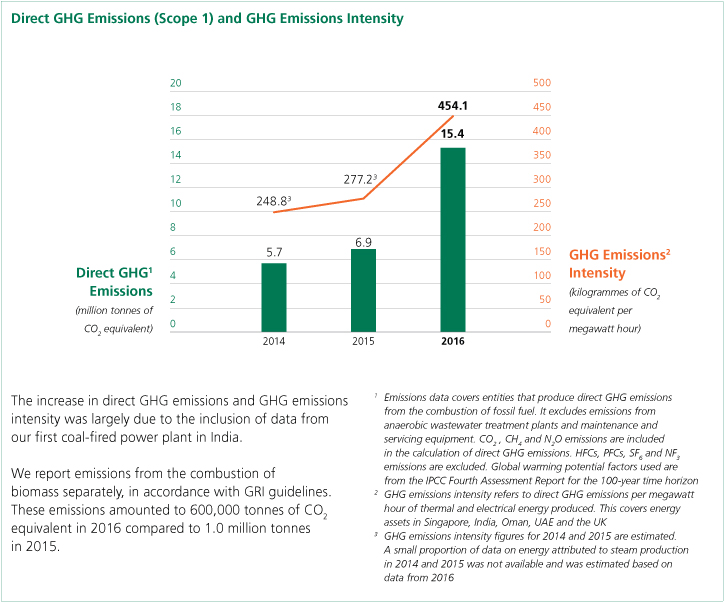
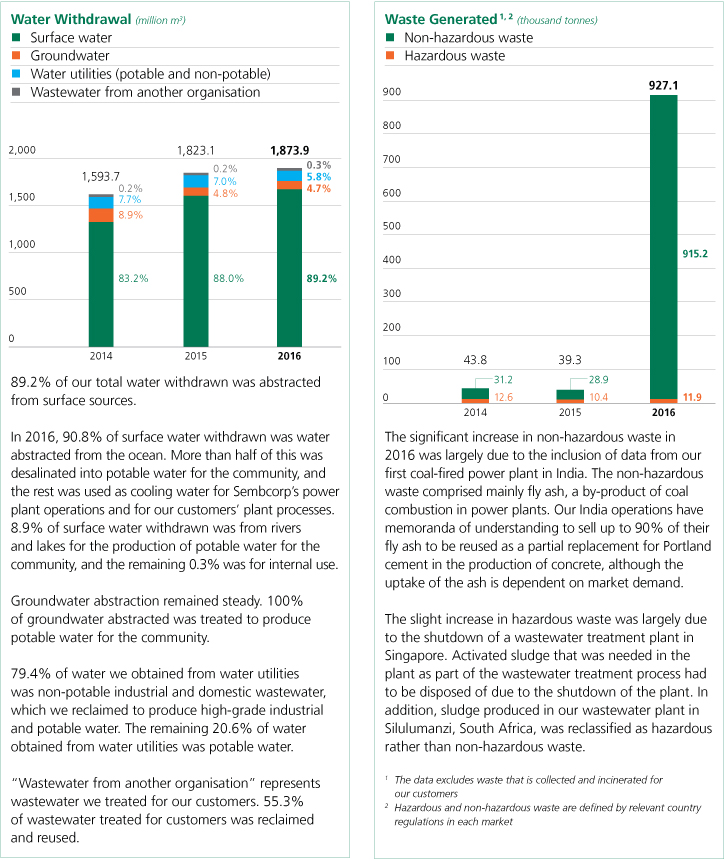
Going forward
We will continue to monitor global, industry and peer action in relation to climate change closely. The way forward requires us to balance stakeholder interests against climate-related and environmental risks, and we are committed to building sustainable businesses that create and deliver long-term value.
We are in the process of implementing our Environmental and Social Policy for New Investments. This policy embeds social and environmental factors into our investment approval process to ensure social and environmental risks are accounted for at the onset of an investment.
We will continue to invest in technology to improve the environmental performance of our facilities. Our operations in India will implement flue gas desulfurisation to reduce emissions while our operations in the UAE will use flue gas heat recovery to increase efficiency. Our energy-from-waste plant in Singapore is expected to commence operations in 2017. The plant will be fuelled by around 1,000 tonnes of industrial and commercial waste per day, roughly 14% of the total tonnage of waste bound for incineration in Singapore every day.
We will leverage the progressive implementation of the Sembcorp Global Asset Management System to strengthen in-house digitalisation and predictive analytics capabilities.
 |
Climate Change
To have a business portfolio that balances the economic expectations of our stakeholders and our businesses’ impact on the climate |
 |
Local Environmental Protection
To fulfil our duty to protect the environment and conserve resources, while providing competitive and reliable solutions for our stakeholders |
 |
Energy and Water Efficiency
To improve energy and water efficiency through good and economically viable environmental practices |
Social
To be a responsible business that ensures the health and safety of our people, and makes
a positive impact on our people and communities
Why this is material
Health and Safety
Sembcorp develops and operates power and water plants as well as other facilities, where extensive health and safety precautions are required. The expansion of our business into developing economies also means we face challenges in building a local workforce that is attuned to our global health and safety standards. It is our priority to ensure that globally, all our employees and contractors are competent and equipped to work safely. We recognise our duty of care to provide a safe workplace for those who step into our premises, and we work hard to fulfil that duty. The health and safety of our customers is also a key priority, especially in our municipal water operations, where any lapse in health and safety protocols could result in a direct impact on people in the community.
Our People
Our employees play a vital role in ensuring we achieve our business strategy and goals. The nature of our business is such that we require specialised technical expertise. However, some of the markets in which we operate lack a qualified labour force with the necessary technical skill sets that our business demands. In other markets, these skill sets are highly sought after across several industries. In addition, the commercial and regulatory environments we operate in are also becoming increasingly complex. Therefore, there is a critical need to retain and develop a capable and motivated workforce who possess a deep understanding of the company and its industry sectors. Of the issues relating to our people, our materiality review process has identified employee development, employee compensation and benefits, labour standards, human rights and diversity, as well as employee wellness to be important areas of focus.
Community
Sembcorp’s long-term success is premised upon being a valued partner to the communities we are in, and we aim to contribute positively to these local communities. While Sembcorp’s businesses play an important role in supporting economic development and improving the standard of living in our communities, we recognise that there are social and environmental impacts on the communities around us as a result of the development and operation of our plants. Therefore, we view our integration with, support of and contribution to our host communities as part of our licence to operate.
Our approach
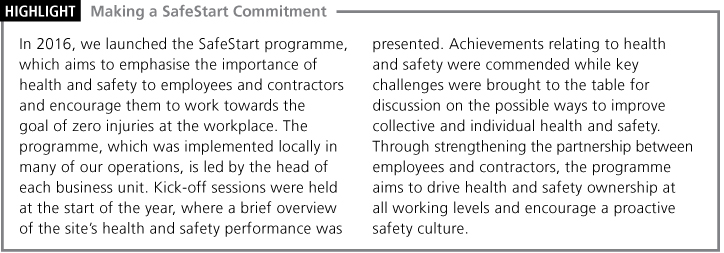
Health and Safety
Occupational health and safety
Our vision is to be an organisation with a proactive health and safety culture. We are committed to working towards the goal of zero injuries in our workplace, with a workforce that puts safety first. We benchmark the health and safety performance of our operations against relevant global industry safety statistics, such as the International Oil and Gas Producers Global Safety Performance Indicators, and aim for progressive improvement.
We have put in place structures and processes to meet our goal including:
-
 Board review
Board review
-
 Oversight by the board’s Risk Committee
Oversight by the board’s Risk Committee
-
 Leadership by our Group President & CEO
Leadership by our Group President & CEO
-
 A Group HSE management system framework comprising
A Group HSE management system framework comprising
— A Group HSE Policy; and
— Group HSE management system guidelines and standards
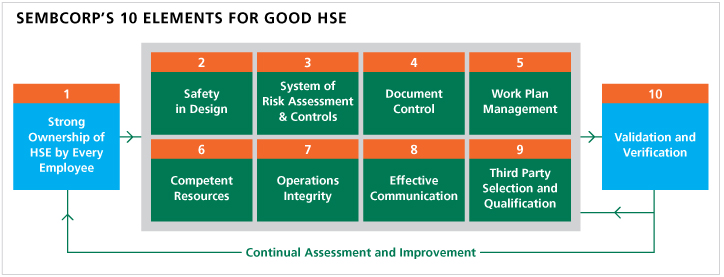
Assurance
HSE assurance is supported by an on-site validation and verification process which evaluates the effectiveness of the plants’ or sites’ HSE controls. On an annual basis, a validation and verification schedule is formulated using an internal risk-based assessment to ensure that the assurance exercise will focus on higher risk areas. Plants or sites with higher risk ratings will be given priority in the assurance exercise. The results of the assurance form the basis for the development of improvement plans.
Training
Providing our employees with relevant HSE and technical capability development ensures that we have competent safety practitioners and safety-conscious line managers that support safe operations. Training is specific to the operations’ or sites’ risk profile and local conditions, and is conducted on an ongoing basis. Examples of operations-specific training include defensive driving at our solid waste management unit as well as project commissioning and construction orientations for project development teams. An annual global HSE workshop is held as a platform for the learning and sharing of corporate initiatives and best practices from our different operations.
Product responsibility: safety and quality
Sembcorp is committed to designing, building, operating and maintaining facilities in a manner that safeguards people, property and the environment.
Product safety and compliance is a priority, as non-compliance can result in serious health, safety and operational issues for our customers, many of whom depend on us for basic utilities or require our products for their industrial processes. Compliance testing of our products is done during various stages, from manufacturing to distribution and supply. We implement a robust maintenance and monitoring regime, which includes stringent inspections and the installation of meters and sensors at both our and our customers’ facilities. We also conduct regular laboratory tests to meet regulatory requirements and ensure that the water we produce is safe for our customers and end users.
Our People
Our operations span 15 countries across five continents where labour laws, regulations, employment codes and practices differ widely. All our local human resource policies comply with the local laws.
Our human resource practices are guided by the following:
-
 Oversight by the board’s Executive Resource & Compensation Committee
Oversight by the board’s Executive Resource & Compensation Committee
-
 Oversight by the Senior Management Committee
Oversight by the Senior Management Committee
-
 Talent Development Committees
Talent Development Committees
-
 Sembcorp Leadership Framework
Sembcorp Leadership Framework
-
 Our Code of Business Conduct
Our Code of Business Conduct
-
 Our Employee Code of Conduct
Our Employee Code of Conduct
-
 Our Grievance Handling Policy
Our Grievance Handling Policy
Employee development
Employee development at Sembcorp is managed through the Sembcorp Leadership Framework, which comprises three components with distinct yet interrelated objectives to drive employee development. Workforce Planning supports organisational growth and ambition. The Core Competency component assesses employees’ competencies and identifies capability gaps while setting performance expectations. Learning and Development programmes are then put in place to close the gaps identified.
To complement the Sembcorp Leadership Framework, Talent Development Committees at both group and business unit levels aim to build a strong pipeline of talent to support our organisation. The committees meet at least twice a year to review our talent pipeline for succession management and leadership development.


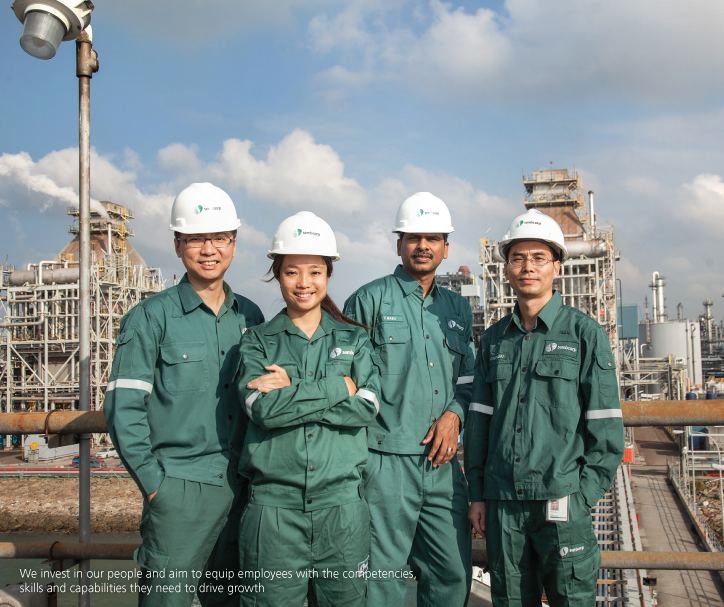


Localisation is an important part of our strategy to grow our overseas businesses. When we begin operating in a new market, employees who are seconded from Singapore and other locations to start up the operations are given a clear responsibility to develop local talent. As the capabilities of local employees grow, the team is gradually localised, and the number of secondees progressively reduced.
Employee compensation and benefits
To attract, motivate and retain employees, Sembcorp’s remuneration and reward system is market competitive and performance-based. To determine salary levels and benefits, regular reviews and benchmarking are conducted against local standards and data from global market surveys and consultancy firms. In countries where there is a minimum wage policy, Sembcorp pays above the minimum wage.
Sembcorp adopts an equal pay policy where rewards are based entirely on merit and performance. Salary increases are based on individual performance and relative placement against the external market as well as negotiations with employee unions and guidelines issued by the local government. Annual variable bonuses are based on the Group’s performance as well as employees’ performance against individual targets set jointly with their supervisors.
We recognise that managing performance and development is a continuous process. Performance appraisals are done through informal feedback sessions and online systems where performance, expectations, training needs and targets are discussed and agreed upon by the employee and supervisor. As part of the performance appraisal, employees will be assessed against Sembcorp’s Core Competency Framework. Going through the appraisal process helps inculcate core values in employees, and clearly articulates the competencies and functional skills needed for their development.
Labour standards
We abide by local laws wherever we operate. Examples of regulations our global operations comply with include the Broad-based Black Economic Empowerment Amendment Act 2013 in South Africa, and localisation requirements as well as local labour laws that do not recognise the right of workers to organise and form trade unions in the Middle East. Sembcorp employees are entitled to practise freedom of association and to be covered by collective bargaining agreements in the workplace, within the regulatory boundaries of each of the jurisdictions. We hold constructive ongoing engagement with employee unions in our various operations. In countries where our operations are covered by collective agreements, we abide by the terms stated in said agreements, including those relating to minimum notice periods. Procedures for grievance handling are also specified in the agreements. Our Grievance Handling Policy seeks to manage employee grievances in a fair and reasonable manner, with an escalation path to the Group President & CEO where necessary. Where collective agreements do not exist, we abide by the terms stated in employment contracts.
Human rights and diversity
We are committed to uphold and respect the spirit of the United Nations Universal Declaration of Human Rights and the International Labour Organization’s Declaration on Fundamental Principles and Rights at Work. We are a signatory to the United Nations Global Compact (UNGC), and have made a public commitment to respect the Ten Principles of the UNGC, one of which is human rights. We abide by the Employers’ Pledge of Fair Employment Practices under Singapore’s Tripartite Alliance for Fair and Progressive Employment Practices. Our Code of Business Conduct sets out our stance on fairness, opportunity, non-discrimination, dignity, respect and harassment. We do not hire forced or child labour in our operations.
Employee wellness
We recognise the impact of wellness on our employees’ overall effectiveness, and have set aside a dedicated wellness budget in countries of major operations such as Singapore, China, India, Oman and the UAE. The budget is available for department heads to use towards activities that encourage employee well-being and team bonding. Sembcorp was a founding member of the iCare Mental Health Alliance, which made efforts to improve the mental health of workers in Singapore. In addition, we specifically include coverage of treatment for mental health issues in our employee insurance coverage. Besides mandatory medical screenings for employees potentially exposed to occupational health hazards, voluntary annual health screenings are available free of charge to all employees in Singapore, China, Oman and the UAE.
Around the world, employee-led committees within our operations organise a range of recreational activities as well as nutrition and stress management programmes to support employees’ physical and mental well-being.
Community
The needs of one community can be very different from another. We believe that our local operations are best placed to not only understand the needs of the community, but also to forge partnerships with local stakeholders. Therefore, while the Group provides the strategic framework, tools and guidelines to ensure consistency and acceptable standards, community assessments and engagements as well as contributions are managed at the local level.
Assessment and engagement
The assessment and engagement of the community is guided by our Group Stakeholder and Community Engagement Policy as well as our Group Community Grievance Policy. Environmental and social impact studies are carried out in accordance with international and / or national standards for major new projects and expansions. These studies typically include social management plans that are implemented by the operations teams through the various stages of the site’s development.
Community contribution
Sembcorp’s global corporate social responsibility (CSR) framework provides a strategic and consistent approach for our charitable contributions and community investments. We focus on fostering environmental stewardship and improving the quality of life of the communities we are in.
Our CSR framework aligns the tracking and reporting of our community contributions with guidelines set by the London Benchmarking Group. This allows us to account for our total community giving – or the amount disbursed through sponsorships or donations – using standard definitions and valuations, and helps us ensure that the contributions recorded are meaningfully spent on community investment activities. More information on our key programmes may be found in the Sustainability section of our website.
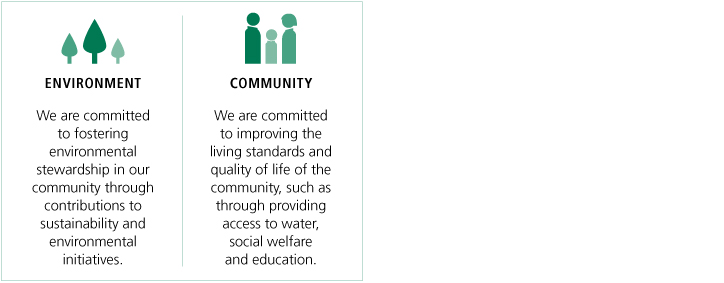

Our performance
Health and Safety
In 2016, we continued to implement several initiatives to improve our health and safety performance.
The key initiatives implemented include:
-
 Nurturing greater health and safety ownership through the SafeStart programme, which aims to strengthen the partnership between our employees and contractors. This programme was implemented by the heads of many of our operations worldwide.
Nurturing greater health and safety ownership through the SafeStart programme, which aims to strengthen the partnership between our employees and contractors. This programme was implemented by the heads of many of our operations worldwide. -
 Enhancing our project development health and safety management through targeted focus on the management and surveillance of construction and commissioning activities, and increased engagement with contractors to ensure adherence to our health and safety requirements.
Enhancing our project development health and safety management through targeted focus on the management and surveillance of construction and commissioning activities, and increased engagement with contractors to ensure adherence to our health and safety requirements. -
 In 2016, our annual validation and verification assurance programme was conducted, covering operations in Singapore, India, South Africa and Chile. The programme includes training and peer assistance elements, and serves a dual purpose as it reviews the health and safety performance of our operations, while enabling the sharing of good health and safety practices among peers.
In 2016, our annual validation and verification assurance programme was conducted, covering operations in Singapore, India, South Africa and Chile. The programme includes training and peer assistance elements, and serves a dual purpose as it reviews the health and safety performance of our operations, while enabling the sharing of good health and safety practices among peers. -
 Conducting root cause analysis training to enhance the identification of health and safety root causes. This two-day training programme was conducted in Singapore involving colleagues from our global business units. This training aims to sharpen our capabilities in applying root cause analysis for incident investigation.
Conducting root cause analysis training to enhance the identification of health and safety root causes. This two-day training programme was conducted in Singapore involving colleagues from our global business units. This training aims to sharpen our capabilities in applying root cause analysis for incident investigation.
It is with great regret that we report three fatalities in 2016 which occurred at two of our construction sites. One fatality was due to a vehicular accident involving our contract worker at a construction site in Singapore. The other two were due to a fall from height and burn injuries sustained by contract workers constructing our second thermal power project in Andhra Pradesh, India. We are very saddened by the loss of these lives. Full support was rendered to the affected families by our operations and human resources teams. Every incident was thoroughly investigated to identify root causes and the necessary corrective actions were taken to prevent recurrence. Comprehensive reviews and assessments were also conducted and additional control measures implemented to minimise risk levels to as low as reasonably practicable. To ensure that we continually improve risk control, Operational Control and Safe Work Procedures are regularly reviewed to ascertain possible areas for improvement. A taskforce was also set up to review our Permit-to-Work systems and evaluate areas for improvement and standardisation.
Our health and safety performance charts reflect group-wide performance and cover both assets in operation and under construction.

The lost time injury rate registered a slight decrease, due to improvements in performance across all operations, except for projects under construction. We recognise that there are improvements to be made for projects under construction, and we are in the process of further strengthening our health and safety controls. The accident severity rate increased due to longer recuperating times required for minor injuries such as sprains and cuts. We will continue to improve our performance through enhancing our health and safety risk assessments and management.
1 Group figures are based on scope included in the reporting year. Our scope in 2014 only covered assets in operation, while our scope in 2015 and 2016 were expanded to include assets under construction
2 Occupational health and safety data includes employees and contractors
3 The lost time injury rate includes fatalities
4 Accident severity rate excludes fatalities. Accident severity rate including
fatalities is reported in our detailed performance data, available in the Sustainability section of our website. We record lost time due to one fatality as 6,000 lost work days, as per the US National Institute for Occupational Safety and Health
Our People
In 2016, we enhanced our Sembcorp Leadership Framework with the implementation of the Sembcorp Leaders Programme and the Occupational Personality Questionnaire and Motivation Questionnaire in Singapore. Emergenetics workshops were conducted for close to 400 employees in China and India. The assessment is a tool for self-evaluation which aims to aid personal and professional development, as well as promote peer understanding and empathy.


Community
In line with our commitment to manage our impact on the community responsibly, and to better mitigate the environmental and social impact of our businesses, we have developed an Environmental and Social Investment Policy for New Investments. The policy embeds the identification of key environmental and social related risks into the early stages of our investment approval process.
In 2016, Sembcorp contributed close to S$4.2 million in cash and in-kind to charities and community initiatives globally. Over S$500,000 comprised mandatory contributions and close to S$13,000 comprised leveraged contributions. These contributions supported causes such as environmental and water conservation education, as well as youth development, apprenticeships and job training programmes. Total volunteer man-hours amounted to more than 14,000 hours, of which 20% were spent outside of working hours due to event requirements.
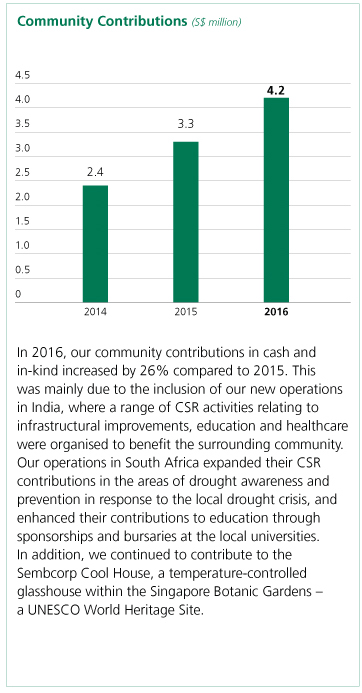
Going forward
Health and Safety
As Sembcorp continues to grow our footprint internationally, we will continue to focus on the following areas to align our businesses to global standards:
-
 Strengthening of health and safety ownership and leadership at all working levels
Strengthening of health and safety ownership and leadership at all working levels -
 Promotion of health and safety communication and engagement
Promotion of health and safety communication and engagement -
 Strengthening of risk management and control measures for both project development and operational activities.
Strengthening of risk management and control measures for both project development and operational activities.
Our People
Moving forward, we are preparing for the global roll-out of programmes under the Sembcorp Leadership Framework. We will also be launching an organisation survey to formally assess organisational health.
Community
We continue to enhance our internal processes for managing our impact on our communities. This includes the implementation and roll-out of our Environmental and Social Policy for New Investments to relevant stakeholders.
 |
Health and Safety
To make health and safety management an integral part of everyday business and culture |
 |
Our People
To offer a compelling employment experience for our people to develop and excel |
 |
Community
To be a responsible business that makes a positive impact on our communities |
Governance
To maintain high standards of behaviour and integrity and be best in class for governance practices

Why this is material
Corporate Governance
We define corporate governance as the structures and processes in place for the transparent and accountable control and governance of our organisation. Well-defined corporate governance processes are essential in enhancing corporate accountability and long-term sustainability to preserve and maximise shareholder value.
Risk Management
Managing risk is an integral part of our business activities. As we continue to grow and expand globally, we are exposed to diverse risks, including strategic, financial, operational, compliance and fraud risks. Besides helping to preserve our bottom line by reducing the likelihood and impact of potential losses, risk management provides a common basis to evaluate new business opportunities. It also assures our board and shareholders that key enterprise and business risks faced by the organisation have been identified, assessed and managed with appropriate risk mitigation and controls.
Compliance
Sembcorp provides essential services which are highly regulated. We are committed to comply with all laws and regulations in the countries that we operate in. Non-compliance may subject us to statutory and regulatory fines and sanctions, including losing our licence to operate and material litigation. It may also result in damage to our reputation and credibility, thereby limiting future growth opportunities.
Ethical Business Practices
Responsible business conduct and ethical business practices ensure the long-term viability of our businesses and build trust and confidence with our stakeholders. We are committed to high standards of behaviour and integrity in everything we do. We believe in conducting our business legally, fairly, honestly and with integrity, and expect the same of those whom we do business with. Sembcorp has zero tolerance for fraud, bribery and corruption.
Our approach
Corporate Governance
Sembcorp is led by an effective board mainly comprising independent non-executive directors. The board is collectively responsible for providing overall strategic direction and ensuring the long-term success of the Group. Several board committees have been established with clear terms of reference, both to assist the board in fulfilling its responsibilities and to provide an independent oversight of management.
Furthermore, the board and management of Sembcorp recognises that well-defined corporate governance processes are essential in enhancing corporate accountability and long-term sustainability, and are committed to high standards of governance to preserve and maximise shareholder value. We comply with the principles and guidelines set out in the Code of Corporate Governance 2012 issued by the Monetary Authority of Singapore, and our corporate governance practices are set out in the Corporate Governance Statement in this annual report.
To facilitate the effective execution of both our internal processes and business needs, we have in place a clearly defined organisational structure which includes detailed roles and responsibilities for key appointment holders. This is further supported by an established delegation of authority matrix and financial authority limits, which have been approved by the board. A comprehensive set of group-wide governance and functional policies that ensure entity-level controls are also implemented across the Group. The Group’s internal controls policy and manual, which adopts principles of the Committee of Sponsoring Organizations of the Treadway Commission, provides a framework for what constitutes an effective and adequate system of internal controls. It also provides guidelines on the appropriate segregation of duties and a checklist of recommended internal controls for our business units to put in place.
We have also put in place a Governance Assurance Framework to provide a holistic and robust basis of assurance for the adequacy and effectiveness of our risk management and internal control system.
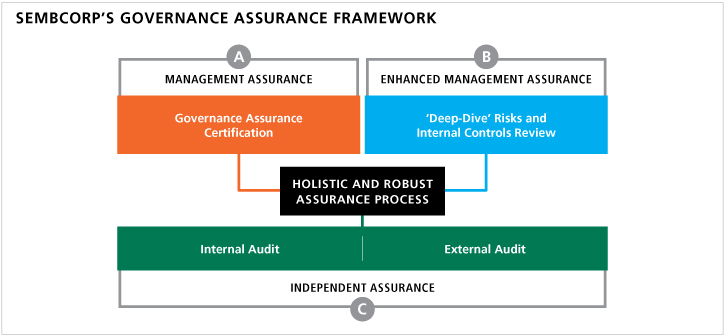
a. Management assurance
The Governance Assurance Certification is a management certification process that is submitted quarterly by each business unit to certify that its risk management and internal controls system is adequate and effective. This certification is supported by regular internal risk management processes, including Risk Management Committee meetings and review of risk registers.
b. Enhanced management assurance
Key business units are required to perform a ‘deep-dive’ risks and internal controls review together with a risk control self-assessment by management.
c. Independent assurance
Internal audit provides independent assurance with a focus on operational risks and the general control environment. External audit considers internal controls relevant to the preparation of financial statements to ensure they give a true and fair view.
Risk Management
The Group manages risk under an overall strategy, determined by the board of directors and supported by the board’s Risk Committee and Audit Committee. The Risk Committee reviews and enhances the effectiveness of the Group’s risk management and HSE plans, systems, processes and procedures. It also regularly reviews group-wide risks including significant risk exposures relating to foreign exchange rates, commodity prices and major investment projects as well as corresponding risk mitigation plans. HSE policies, guidelines and limits are also regularly reviewed. Oversight for risk management within the Group’s listed entities lies with their respective boards.
Risk appetite framework
The board has determined a risk appetite framework for Sembcorp that forms a common understanding among both our board and management to execute the Group’s strategy and objectives. Under this framework, the board has approved risk appetite statements with respect to the following areas. These are aligned with how the Group categorises its material issues, for the management and the reporting of its overall sustainability performance:

a. Economic
Sembcorp actively pursues global strategies to deliver sustainable long-term value and growth. We will continue to invest in and develop our capabilities and expand our assets in both existing and new markets, with a particular emphasis on emerging markets. Investing in such markets inevitably carries with it inherent risks; however, the Group is a disciplined investor with a robust investment approval process that calls for the necessary due diligence and risk management to be done. The Group has a defined set of country limits and the limit for investment exposure in countries deemed to be of high and medium risk has been set at no more than 65% of our total investment exposure. In addition, we also maintain appropriate single-country limits.
The Group commits to maintaining a strong financial position and targets to achieve an investment grade equivalent credit rating to ensure access to funding and protect shareholder value. The Group will not take part in any form of transaction that is deemed speculative in nature, under any circumstances.
The Group commits to maintaining a strong financial position and targets to achieve an investment grade equivalent credit rating to ensure access to funding and protect shareholder value. The Group will not take part in any form of transaction that is deemed speculative in nature, under any circumstances.
b. Environmental
Sembcorp is committed to responsibly managing and reducing our impact on the environment as well as to effectively managing environmental risks to our operations.
Besides complying with all prescribed environmental standards and requirements through our established internal policies and processes, we assess the impact of environmental risks and apply appropriate control measures to manage them. Where viable, we also invest in the latest technologies and utilise our capabilities as an industry leader to achieve better energy and water efficiency, including reduction of water consumption through water reuse.
Besides complying with all prescribed environmental standards and requirements through our established internal policies and processes, we assess the impact of environmental risks and apply appropriate control measures to manage them. Where viable, we also invest in the latest technologies and utilise our capabilities as an industry leader to achieve better energy and water efficiency, including reduction of water consumption through water reuse.
c. Social
Sembcorp is committed to being a responsible business that ensures the health and safety of our people, and makes a positive impact on our people and communities.
In our pursuit of operational excellence and business growth, Sembcorp will not compromise the health and safety of both its internal and external stakeholders. The health and safety of all our employees is of paramount importance to the Group. We take a serious view of any breach in health and safety standards and regulations across all our operations and facilities.
Sembcorp also recognises the need to have in place a strong and competent workforce that is committed to our core values and ethical standards. The Group will also continue to attract, develop and retain employees with the relevant skill sets and competencies to meet our business needs and growth plans and ensure leadership continuity.
In addition, Sembcorp believes that as an integral part of our communities, we should conduct our business in a responsible manner and make a positive contribution to the communities in which we operate. The Group is therefore committed to high standards of business conduct, to engaging our stakeholders and to managing our environmental and social impact on local communities responsibly.
In our pursuit of operational excellence and business growth, Sembcorp will not compromise the health and safety of both its internal and external stakeholders. The health and safety of all our employees is of paramount importance to the Group. We take a serious view of any breach in health and safety standards and regulations across all our operations and facilities.
Sembcorp also recognises the need to have in place a strong and competent workforce that is committed to our core values and ethical standards. The Group will also continue to attract, develop and retain employees with the relevant skill sets and competencies to meet our business needs and growth plans and ensure leadership continuity.
In addition, Sembcorp believes that as an integral part of our communities, we should conduct our business in a responsible manner and make a positive contribution to the communities in which we operate. The Group is therefore committed to high standards of business conduct, to engaging our stakeholders and to managing our environmental and social impact on local communities responsibly.
d. Governance
As a listed company on the Singapore stock exchange that has both responsibility and accountability to a wide range of stakeholders, Sembcorp commits to maintain high standards of behaviour and integrity and be best in class for governance practices. The Group will comply with all applicable laws and regulatory requirements in the countries where it operates. Further, the Group adopts a zero tolerance stance towards any form of fraud, bribery or corruption and expects all employees to adhere to the guidelines set forth in the Code of Business Conduct.
The above risk appetite statements are also supported by key risk indicators, which are monitored and reported to the Risk Committee on an ongoing basis.
Enterprise risk management
The Group is committed to ensuring that an effective and practical enterprise risk management (ERM) framework is in place. Our framework aims to safeguard our people and assets, protect shareholders’ interests, facilitate informed decisions for value creation and ultimately enhance our brand and reputation. In designing our ERM framework, the Group has adapted and made reference to various industry risk management standards, such as ISO 31000 and the Enterprise Risk Management – Integrated Framework of the Committee of Sponsoring Organizations of the Treadway Commission. This ensures that we are in line with best practice. To sustain a successful ERM programme, we believe in having the right processes and tools as well as instilling the right risk awareness culture. Our ERM framework specifically sets out a systematic and structured approach towards risk management through the following activities:
-
 Awareness trainings and workshops
Awareness trainings and workshops -
 Risk identification and assessment
Risk identification and assessment -
 Formulation of key risk management strategies
Formulation of key risk management strategies -
 Design and implementation of risk mitigation controls (preventive, detective and responsive controls)
Design and implementation of risk mitigation controls (preventive, detective and responsive controls) -
 Monitoring and timely reporting of risk management performance and risk exposure levels
Monitoring and timely reporting of risk management performance and risk exposure levels -
 Continuous improvement of risk management mitigation measures and capabilities
Continuous improvement of risk management mitigation measures and capabilities
Our ERM framework is supported by the following key pillars:
a. Fraud risk management
Sembcorp has zero tolerance for fraud, which we take to include corruption and bribery. Our fraud risk management policy provides a framework and comprehensive guidance on anti-fraud measures to proactively manage the risk of fraud, bribery and corruption. This includes a whistle-blowing policy.
The following key activities and complementary policies and procedures are part of our holistic approach towards fraud risk management and also address the risk of bribery and corruption:
Preventive anti-fraud measures
Detective anti-fraud measures
Responsive anti-fraud measures
The following key activities and complementary policies and procedures are part of our holistic approach towards fraud risk management and also address the risk of bribery and corruption:
Preventive anti-fraud measures
-
 Code of Business Conduct
Code of Business Conduct -
 Employee code of conduct
Employee code of conduct -
 Conflict of interest policy
Conflict of interest policy -
 Corporate gift policy
Corporate gift policy -
 Fraud risk assessments
Fraud risk assessments -
 Employee and third party due diligence
Employee and third party due diligence
Detective anti-fraud measures
-
 Whistle-blowing policy
Whistle-blowing policy -
 Forensic data analysis
Forensic data analysis -
 Compliance and monitoring
Compliance and monitoring -
 Pre-employment screening
Pre-employment screening
Responsive anti-fraud measures
-
 Fraud reporting procedures
Fraud reporting procedures -
 Fraud investigation procedures
Fraud investigation procedures -
 Grievance handling procedures
Grievance handling procedures
b. Operational risk management
The Group’s management of operational risk
is focused on the following areas:
Crisis management and business continuity
A robust and effective crisis management framework is put in place with the Group’s crisis management, emergency response and business continuity procedures, and plans are regularly tested and fine-tuned. The Group also addresses crises and emergencies through the implementation of appropriate prevention, preparedness, response and recovery programmes.
Health, safety and the environment
A group-wide HSE management system which is aligned with international standards and industry best practice sets the standard for business units to actively manage HSE risks.
Insurance
The Group actively reviews its insurable and uninsurable risks, and identifies comprehensive and cost-effective risk management tools to manage such risks.
c. Financial, market and credit risk management
Crisis management and business continuity
A robust and effective crisis management framework is put in place with the Group’s crisis management, emergency response and business continuity procedures, and plans are regularly tested and fine-tuned. The Group also addresses crises and emergencies through the implementation of appropriate prevention, preparedness, response and recovery programmes.
Health, safety and the environment
A group-wide HSE management system which is aligned with international standards and industry best practice sets the standard for business units to actively manage HSE risks.
Insurance
The Group actively reviews its insurable and uninsurable risks, and identifies comprehensive and cost-effective risk management tools to manage such risks.
Sembcorp’s financial, market and credit risk exposure is managed via established policies, including treasury policies, financial authority limits and Governance Assurance Certification.
Financial and market risk
The Group defines and utilises approved financial instruments to manage exposure to foreign exchange, commodity prices and interest rate fluctuations arising from operational, financing and investment activities. Under the Group’s overall treasury policy, transactions for speculative purposes are strictly not allowed.
Default and counterparty credit risks
A group-wide credit risk policy has been put in place to ensure that we transact with creditworthy counterparties as much as possible. We also screen for material concentrations of credit risk to ensure that no single counterparty or group related counterparties has excessive credit exposure that may result in material impact on the Group in the event of a default.
Financial and market risk
The Group defines and utilises approved financial instruments to manage exposure to foreign exchange, commodity prices and interest rate fluctuations arising from operational, financing and investment activities. Under the Group’s overall treasury policy, transactions for speculative purposes are strictly not allowed.
Default and counterparty credit risks
A group-wide credit risk policy has been put in place to ensure that we transact with creditworthy counterparties as much as possible. We also screen for material concentrations of credit risk to ensure that no single counterparty or group related counterparties has excessive credit exposure that may result in material impact on the Group in the event of a default.
d. Investment risk management
The Group has in place an investment approval process to ensure a prudent and disciplined approach to all investment decisions, including a country risk framework that sets appropriate country risk limits.
e. Tax risk management
It is our policy to comply with all relevant taxation laws, regulations and regulatory disclosure requirements.
For more details on our ERM framework and a full description of our approach to managing the above risks, please refer to the Sustainability section of our website.
Compliance
Full compliance to all legal and regulatory requirements is the minimum expectation we prescribe for all our businesses. As part of our Governance Assurance Framework, our Governance Assurance Certification process requires all heads of business units to certify that they have complied with all relevant legal and regulatory requirements in their respective entities and country of operation. Any monetary fines and non-monetary sanctions imposed on the business units are also to be reported.
Regular audits are conducted by Group Internal Audit and Group HSE departments to ensure compliance and also to identify gaps and lapses in compliance. They will also work closely with management to develop action plans to prevent future recurrences of gaps and lapses.
Ethical Business Practices
Sembcorp’s core values of Insight, Integrity and Integral define our approach to sustainable growth and form the foundation of Sembcorp’s Business Principles and Code of Business Conduct (CBC). Employees are required to comply with the requirements of the CBC, which addresses Sembcorp’s stance in the following key areas:
-
 Fairness and opportunity, harassment, information protection and insider trading, protection of company assets
Fairness and opportunity, harassment, information protection and insider trading, protection of company assets -
 Integrity of information, gifts and entertainment, conflict of interest, corruption and bribery, facilitation payments, anti-competition and anti-trust laws, money laundering prevention, political contributions
Integrity of information, gifts and entertainment, conflict of interest, corruption and bribery, facilitation payments, anti-competition and anti-trust laws, money laundering prevention, political contributions -
 Contribution to our communities, health, safety and the environment
Contribution to our communities, health, safety and the environment
The CBC is publicly available on our website. Requirements of the CBC are communicated to employees globally through an e-learning course delivered in multiple languages. Employees are required to complete an annual declaration to acknowledge that they have read and understood the principles and requirements of the CBC and agree to comply with its principles and requirements and to promptly report any violation through available reporting channels. Suppliers and contractors who work with Sembcorp are expected to respect and follow the CBC as well.
The CBC also provides for escalation procedures in the event of a breach of the CBC as well as feedback channels for employee clarification and queries.
Our performance
The focus of our governance assurance process this year was to extend the implementation of the Governance Assurance Framework to new entities. We also continued to review and update the risk registers of existing entities to ensure that they remain relevant and up to date. Under a new requirement of India’s Companies Act, the external auditors of our subsidiaries in India have opined that these subsidiaries have, in all material respects, an adequate internal financial controls system over financial reporting and that these controls were operating effectively as at March 31, 2016.
As part of our ongoing efforts to build in-house capabilities, readiness and resilience in crisis and emergency response situations, we have continued to conduct and participate in regular crisis simulation exercises and awareness trainings. In 2016, this included simulation exercises in Singapore, Oman and the UAE. The exercises were conducted in partnership with customers, local authorities and external agencies.
With heightened risk of terrorist attacks worldwide, we have also engaged an external consultant to review our security framework and ensure that our organisation and staff are well-prepared in responding to major security incidents. In September 2016, Temasek Foundation Cares launched the Stay Prepared – Business Psychological Resilience Programme (B-PREP) to establish a model for psychological resilience, which companies in Singapore can adopt to help manage the psychological and emotional impact of emergencies, threats and crises. As a B-PREP participant, we have embarked on building a team of trained personnel equipped to help affected persons cope with the psychological and emotional impact of crises. We are also developing a psychological resilience framework in line with national resilience frameworks such as SG Secure and the National Care Management System.
In 2016, Sembcorp received the Most Transparent Company Award in the Industrials category at the Securities Investors Association (Singapore) Investors’ Choice Awards. Sembcorp was also ranked sixth in the 2016 edition of the Singapore Governance and Transparency Index, a well-respected index assessing the transparency of 631 Singapore listed companies. The index is a collaboration between CPA Australia, the Centre for Governance, Institutions and Organisations at the National University of Singapore Business School, and the Singapore Institute of Directors, and is supported by The Business Times.
During the year, three significant fines amounting to S$260,000 were incurred by our operations in Chile and China. One of our water treatment plants in Chile paid a total penalty of S$156,000 for failure to provide continuous water supply and meet the required water pressure level on two occasions. New wells have been constructed and enhancements have been made to improve the capacity and water pressure. A water treatment plant in China was also fined S$104,000 when samples tested by the Environmental Protection Bureau exceeded the chemical oxygen demand limit as a result of different laboratory testing methodologies. We have taken action to prevent recurrence of this incident.
There was no legal action initiated during the year in connection with anti-competitive behaviour, anti-trust or monopoly practices.
Going forward
We will continue to prescribe to and be guided by the below targets as we continue our journey in pursuit of excellence in the areas of corporate governance, risk management, compliance and ethical business practices.
Going forward, our focus will be to further improve and refine our risk management and governance processes. This includes exploring new e-learning training modules and implementing the new online risk management and business continuity management system for our key business units.
 |
Corporate Governance
To have an effective governance and decision-making structure |
 |
Risk Management
To ensure effective identification and management of all material risks |
 |
Compliance
To comply with all legal and regulatory requirements |
 |
Ethical Business Practices
To ensure we conduct our businesses legally, fairly, honestly and with integrity |
